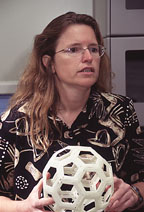geotimesheader
News
Notes
Geochemistry
Buckyballs
hunt down space dust
Scientists supporting
the idea that impact events from meteors or asteroids caused many of Earth’s
mass extinctions may now have a new tool to help search for clues. Fullerenes,
sphere-shaped carbon molecules that look like soccer balls, are often formed
in space. Fullerenes with 60 or more atoms can trap noble gases such as
helium. On Earth, these carbon soccer balls protect helium and other noble
gases from the atmosphere, according to a recent report.
| “Fullerenes with trapped helium could be a very
robust tracer of extraterrestrial flux,” says Luann Becker of the University
of Hawaii and lead author of the report published in the March 28 Proceedings
of the National Academy of Sciences. When other tracers are not obvious,
such as iridium or shocked quartz, fullerenes and helium may also help
indicate whether mass extinctions at boundary events could be related to
impacts, she says.
Becker, Robert J. Poreda of the University of
Rochester and Ted E. Bunch of NASA Ames Research Center discovered fullerenes
containing noble gases in the Allende and Murchison meteorites as well
as in the Cretaceous/Tertiary boundary layer. The fullerenes trapped helium
well above the ratios accepted for solar wind or reported for Earth’s
mantle. |

Luann Becker holds a buckyball.
University of Hawaii
|
“This is going to be an important area of research
for a long time,” says Paul R. Renne, director of the University of California
at Berkeley Geochronology Center. “It is a complex problem with many questions
about how the fullerenes form, and under what pressure and temperature.
Did they come in on the meteors or rather were they formed on impact?”
Initially, Becker, Poreda and Jeffrey L. Bada
of Scripps Institution of Oceanography became interested in investigating
the K/T boundary as well as two carbonaceous chrondrite meteorites after
studying carbon-60 and carbon-70 fullerenes found in the Sudbury Impact
Structure in Ontario, Canada, in 1996. The fullerenes contained trapped
helium with ratios similar to those in interplanetary dust particles.
Fullerenes were originally discovered in 1985.
In 1996, three chemists won the Nobel Prize for identifying the most symmetrical
of the fullerenes: buckminsterfullerene. Also known as buckyballs, the
fullerenes’ 60 carbon atoms are linked together in 12 pentagons and 20
hexagons and look similar in structure to the geodesic dome designed by
R. Buckminster Fuller.
In 1994, other researchers had detected carbon-60
and other large fullerenes at the K/T boundary. However, those researchers
were not investigating fullerenes’ ability to trap noble gases and said
the carbon molecules appeared in the boundary because of massive wildfires
triggered by the impact event.
“Our interpretation is the first to report helium
trapped in fullerene isolated from the boundary layer,” Becker says. “We
did look above and below the K/T boundary and we did not find fullerene
or helium. In this way fullerene and helium seem to be coupled with iridium.”
Evidence of high iridium levels, shocked quartz,
microtektites, spherules, spinel from contact metamorphism, and diamonds
all helped identify the impact at the K/T boundary. But so far, it is the
only impact linked to a mass extinction.
Fullerenes may help provide a tracer of extraterrestrial
material at times of climatic and biostratigraphic change, Becker says.
She is currently working on identifying helium ratios in fullerenes found
at the Permian/Triassic boundary. “We hope to be able to determine how
much material was coming to Earth and will further evaluate how these events
coincide with what we see in the geologic record.”
Christina Reed
